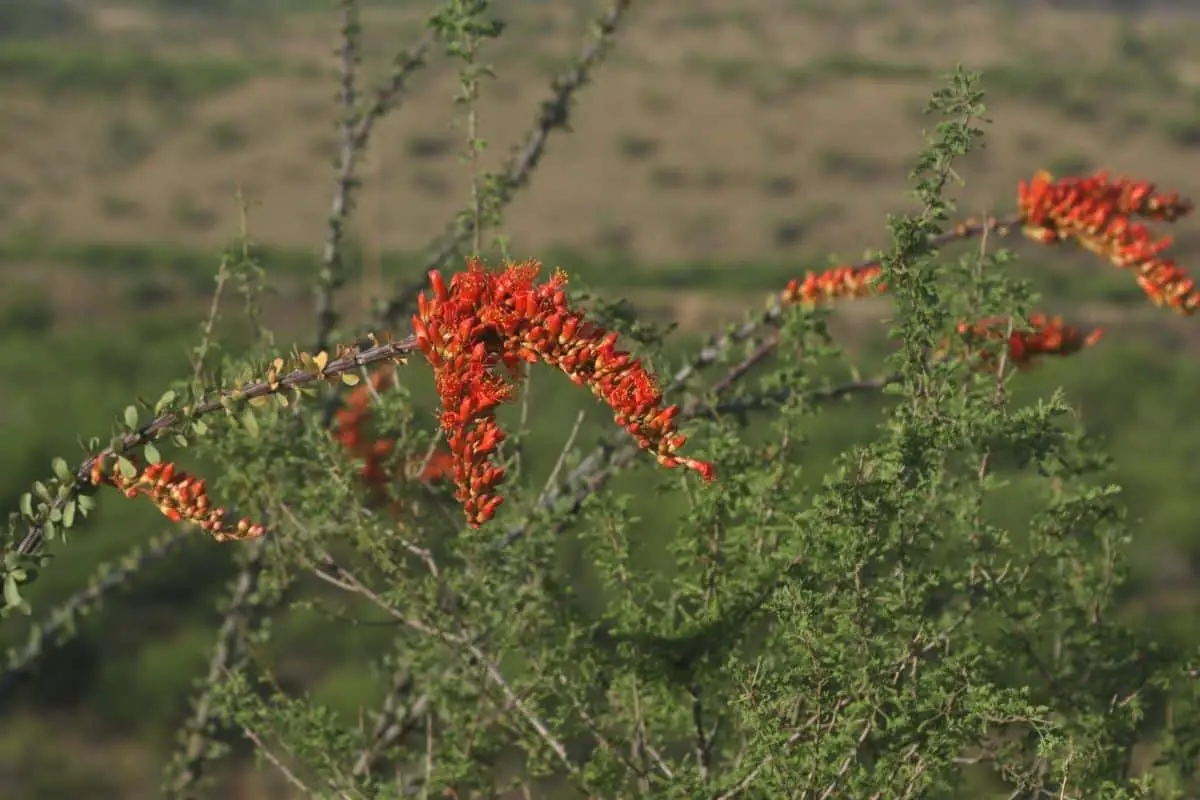There are 11 recognized species in the Fouquieria genus. The most well-known of these is the boojum tree (Fouquieria columnaris) and the ocotillo (Fouquieria splendens).
All the plants in this genus have semi-succulent stems with mostly short sharp spines jutting out from these stems where the original leaves grew. One of the most interesting characteristics of plants in this genus is that they are drought-deciduous.
This means that they will drop their leaves when water is scarce and then regrow them after a rainfall. Although these plants look a little like cacti they are, in fact, xerophytic woody shrubs or trees and are not in the Cactaceae family.
Rather, they have been allocated their own family (Fouquieriaceae). This attests to the uniqueness of these plants.
All plants in the Fouquieria genus originate from arid desert regions in northern Mexico, Arizona, southern California, Texas, and New Mexico.
Here’s a brief description of each plant in this genus.
Fouquieria burragei (Baja Tree Ocotillo)
This is not a common variety and may be difficult to find in cultivation. It’s a multi-stemmed shrub with small, ovate leaves that are grayish-green in color as well as short, sharp spines.
Flowers are produced on longish bracts at the end of each stem and can be either white or pink in color.
Fouquieria columnaris (Boojum tree)
This tree has a semi-succulent tall stem or trunk with short sharp spines and thin branches protruding from it horizontally. Small leaves grow on both the trunk and the branches when there is ample water available. The tree can grow up to 60 feet tall but is extremely slow-growing.
After rainfall in late summer, the boojum tree produces clusters of white or yellow-orange flowers generally at the tip. These flowers are tubular and fragrant.
Fouquieria diguetii (Palo Adan or Adam’s Tree)
This is a tree-like shrub that can reach a height of 20 feet. It’s somewhat similar to the ocotillo tree but has a thicker and more defined trunk. This trunk produces multiple upright branches with small leaves and sharp spines.
This shrub produces an abundance of red, tubular flowers from February through to May. These flowers are attractive to hummingbirds.
Fouquieria fasciculata
This is another rare specimen and is not often found in cultivation. It has a bizarre-looking swollen bottle-shaped base with a multitude of thin, spiny upward branches. These are covered with small leaves that drop off when water is scarce.
The plant produces clusters of white, tubular flowers in winter.
Fouquieria formosa
This is a multi-stemmed variety with thick green stems that exhibit a peeling bark look. The leaves are small and dark green and the flowers are tubular and orange.
Fouquieria leonilae
This is one of the rarest of all Fouquiera species. It has thin branches with only very short spines that are quite sparse. It produces dark-red flowers when the plant is only one to two feet high. This species is quite sensitive to cooler temperatures below 28 degrees Fahrenheit and prone to root rot if overwatered.
Fouquieria macdougalii (Mexican Ocotillo tree or Candlewood tree)
The candlewood tree has a short, thick trunk that holds water. There are numerous reddish-brown branches that grow from this trunk. These branches have spines and small roundish leaves. This tree can reach a height of 20 feet.
In spring and sometimes at other times of the year, the tree produces clusters of flowers at the ends of its branches. These flowers are scarlet in color and tubular.
Fouquieria ochoterenae
This is another rare Fouquieria and is difficult to find in cultivation. It has multiple upright stems. It does not tolerate temperatures below 30 degrees Fahrenheit and is quite difficult to grow.
Interestingly, the leaves turn a lovely maroon color when the plant is under stress and the flowers are also a deep maroon. However, the plant needs to reach a height of around four to five feet before it will produce flowers.
Fouquieria purpusii
Similar to the boojum tree, this species forms a trunk but it’s not as pronounced. However, the tree does have a unique growth habit where the branches tend to twist and turn in every direction.
This species is extremely slow-growing and produces white flowers when it reaches a height of around three to four feet.
Fouquieria shrevei
This species of Fouquieria is very rarely available in cultivation. It is also one of the slowest growing. It features multiple stems from the base with very profuse and longer spines.
The flowers on this plant are also quite unique in that they are not formed in clusters but singularly from at the base of the thorns. The flowers are also pure white.
Fouquieria splendens (Ocotillo or Devil’s Coachwhip)
The ocotillo has multiple stems growing from the base rather than just a single trunk. These stems can reach a height of 15 feet. Small leaves and sharp thorns adorn the stems. During periods of drought, the leaves will drop and be replaced when it rains again.
In spring, this shrub produces waxy tubular flowers in dense clusters on the ends of each stem. These flowers are heavy with nectar and are attractive to many bird species including hummingbirds and finches. Bees also love the flowers for their nectar.
~ image source: depositphotos/vagabond54

